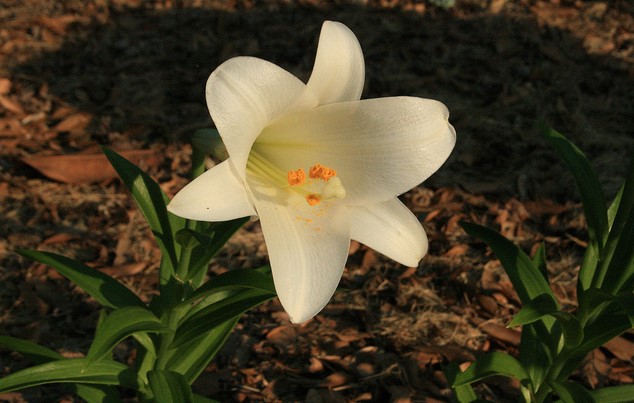Easter Lilies signify the onset of spring and are considered a traditional symbol of the Easter season by many. Easter Lily plants have beautiful, trumpet shaped white flowers. They serve as a traditional gift and adornment during the Easter holiday for many who celebrate.
Easter lilies have large blooms, generally 3-7 inches in width, and small lovely. Most Easter lilies are purchased in pots or decorative planters in the spring. However, they can last much longer than the holiday weekend.
There’s no need to dispose of the entire plant when the blooms are gone after Easter. You can easily transplant your lily outdoors to enjoy year-after-year. We’ve outlined all the information you need to know right here.
You’ll start by caring for your plant indoors until the weather is right to transfer the bulb(s) outside. No worries, this is easier than it sounds. Even if you don’t have a green thumb.
Be certain that you don’t miss the Frequently Asked Questions at the very bottom for some helpful tips and additional information.
If you’re looking for more helpful Easter content check out our tips for The Best Way to Prep Easter Eggs Before Dyeing and one of my personal favorites the Easter Showdown Real Eggs vs. Plastic Eggs.
Now, let’s get started reviving your Easter lilies so you can enjoy them for many years to come!


Indoor Care
Easter weekend has passed and now it’s time to begin caring for your plant so you can prepare the bulb for transfer. First, you’ll need to pick a suitable location with enough light, but not too much. An Easter lily prefers cooler temperatures, especially at night. A great place to consider is the base of a sunny window but out of the direct sun rays.
Next, snip away fading flowers from the plant using sterilized scissors. Water the soil whenever it’s dry to the touch, and make sure not to overwater. After this, fertilize the flower every 14 days with half-strength liquid fertilizer. Remove the foliage at the soil level when it fully withers.


Be sure to maintain a cool temperature to ensure a blossom in the coming summer. An indoor temperature of 65-75 degrees Fahrenheit is ideal.
You now have two options for the final steps. Harvest the bulb for planting in spring, or plant outdoors now. This all depends on the timing of the Easter season and the climate in your area.
If you live in a climate that experiences extremely cold winters, and it is still a bit cold at Easter, you will want to harvest the bulb for planting in early spring. Withdraw the bulb(s) from the pot, brush off the sticky soil on the roots and place them in properly labeled bags. Store the bulbs in a cold place but avoid freezing conditions.
According to Greenhouse Management, you should store Easter Lily bulbs for up to 42 days between 40 degrees Fahrenheit to 45 degrees Fahrenheit. A refrigerator is a great location. Add the bulbs to a container with a small amount of peat moss. If the bulbs are kept at a higher temperature they may sprout and then not bloom as desired.
If you live in a moderate climate, you may go ahead and transfer your bulb as soon as the flowers have withered from the plant.
The best time to plant is before the summer temperatures climb too high. You want to give the bulb time to settle in before sprouting.
Plant Your Bulb
Look for a location that enjoys morning sun and afternoon shade. Dig an 8 inch deep hole and cover the bulb with at least 3-6 inches of soil. Pro-tip add compost to the bottom of the hole, for extra nutrients, before adding your bulb.
Give at least 12-18 inches of space between bulbs as lilies grow up and out.
Lilies enjoy shade, so add mulch around the plant if possible. Add about 2 to 3 inches of mulch around the base of the bulb. This helps to prevent water evaporation and keeps the soil cool.
Water your new bulb.
Outdoor Care
After some supervision, your Easter Lilies will bloom again in the summer, fall, or the following year.
When outdoors, keep the plant well hydrated. Consistently water the Easter lily after transplanting, every few days for some weeks. This will allow the plant to stabilize inside the soil.


Once the flower sets itself in the new earth, you don’t have to keep watering as much. Note that all lilies can survive drought for a long time, and the Easter Lily flower isn’t an exception.
There’s no need to add any fertilizer right away as Easter Lilies do not need much fertilizer to bloom. However, in successive years, you may want to mix some bulb fertilizer to the base of the plant in early spring before flowering. Still, this isn’t essential for the lily to bloom annually.
An essential aspect is mulching the Easter Lilies to protect the roots and maintain moisture content under the soil. Add an additional layer of mulch in the fall to protect the bulb through the winter.
Pro-tip- trim any withered foliage in the fall before winter sets in.
Final Thoughts
There’s no need to disperse those leftover Easter Lilies since it’s easy to revive them. Start with the indoor care routine before moving the flower outdoors. Maintaining your lily plants outside is a snap!
If you’re looking to get lilies at discounted prices, immediately after Easter is an excellent time to find a good deal.
Frequently Asked Questions
How long do Easter Lilies live? The average is somewhere between 1-2 weeks for floral blooms. The plant will continue living, but there will be no more floral blooms. Easter lilies can live for several years if planted outdoors.
Will Easter lilies spread? Yes, Easter lilies can spread. Just like any other plant that is well maintained outdoors, the Easter lily bulbs can multiply each year.
Do Easter lilies come back? Yes, Easter lilies can bloom again-and-again, year-after-year if planted in a suitable outdoor location. They are a very hardy perennial. If you want to enjoy your lily for years to come we recommend making the transfer to a permanent, in-ground, outdoor location.
How long do Easter lilies bloom? Most Easter lilies will bloom for 1-2 weeks. The blooming period can be shorter if the plant is kept indoors in high heat. Easter lilies prefer cool temperatures around 60-75 degrees Fahrenheit.
Are Easter lilies poisonous to dogs? Yes. You should avoid leaving your Easter lily plant within reach of your dog. Dogs who accidentally ingest any of the lily may suffer from some stomach distress and digestion issues. Pro-tip make sure your plant cannot drop leaves or petals to the floor while you aren’t around. It’s better to keep this plant way out of reach to protect your precious pooch.
Are Easter lilies poisonous to cats? Yes. Cats are highly allergic to lily plants. Even ingesting a small piece may cause death. The most common way this occurs is through kidney failure. Whereas you can place an Easter lily on a high shelf to keep it away from a dog, this is not the same for cats. We recommend that you do not bring an Easter lily into your home or yard if you have a pet cat.
How tall are Easter lilies? Easter lily plants, planted outdoors, can grow as high as 3 feet tall. Make sure to plant your bulbs with at least 12-18 inches of space on either side. Lilies grow up, but also out so you want to give them ample space.






